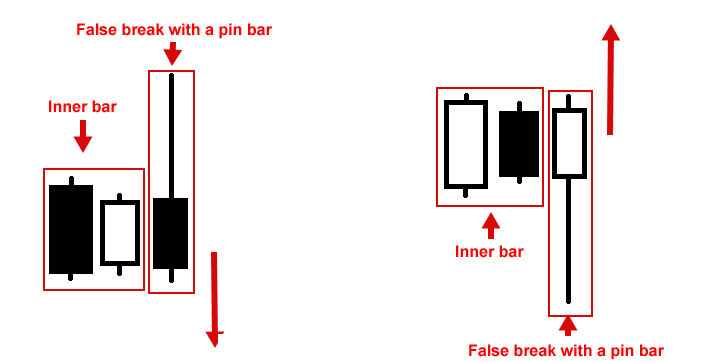Trading false breaks with the Falsey
The Falsey candlestick structure Fakey is a potentially reliable short term (and sometimes long-term) indicator of the market's direction. A falsey is the false break of an inner candlestick.
The falsey indicates that institutional traders (banks and hedge funds) have hunted down the stop loss levels of small retail taders to get them out of their positions and create a price "vacuum" to reverse the market's trend. The falsey can also indicate that institutional traders have reacted to a market event, suddenly driving price in a direction that is opposite to the initial direction.
The falsey is a very strong signal that suggests that price may continue to move in the direction that is opposite of the false break.
In the below example, we see a bearish and bullish falsey signal. Notice that there is first an inner candlestick, followed by a false breakout of this model which results in a falsey setup:

Note: not all falsey signals are exactly like this one, there are variations such as the falsey with a pin bar. In the case of a pin bar, the false break is represented by a single candlestick, unlike the false break structure that has 2 candlesticks such as the one shown in the picture above. There are also false break structures that feature 3 candlesticks, but they are rarer and not as ideal as a falsey with 1 pin bar or 2 candlesticks.
In the below example, we see a bullish and bearish falsey with a pin bar that represents the false break of the inner bar:

How to trade a falsey signal
A falsey signal works in almost all market conditions except in volatile markets. It can be used in a trending market or in a lateral range, defined by horizontal support and resistance levels, or even against a trend if it hits a support level or a key resistance level.
The falsey provides us with a good entry point as well as an obvious stop loss level. Let's take a look at some examples to clarify this.
In the below example, we can see that the market was in an uptrend before hitting a period of consolidation, and then a falsey buy signal formed at the consolidation area's support level. The stop loss should logically be placed below the lowest false breakout. This falsey formed on a confluent chart level, as several points indicate that a support level has formed beneath the uptrend.

Let's look at another example of a falsey signal at the resistance level of a horizontal range. The false breakout on this falsey is not quite a pin bar because the body of the candlestick is too large relative to the wick, but it's still a reversal bar.

Caution:
A falsey will not always be "perfect", there is some discretionary decisions that are involved, but one's trading instinct is what separates the amateur traders from pros.
For example, there should only be 1 inner bar in a falsey structure, sometimes you will see 2 or 3 inner bars or perhaps more. In the below example, we see a falsey + pin bar with 2 inner bars.

The key characteristic of a good falsey signal is the false break of an inner bar structure. If you see an OBVIOUS false break of an inner bar, you have a good falsey on your hands if there is certain confluence with the support & resistance levels and its direction in the context of the market. The best falseys are obvious and don't require a lot of detective work.
The falsey is a price action pattern that is extremely powerful if you know how to spot it well and trade it well. A false breakout is a very good indication of what institutional traders are doing and it gives us the opportunity to take advantage of this.